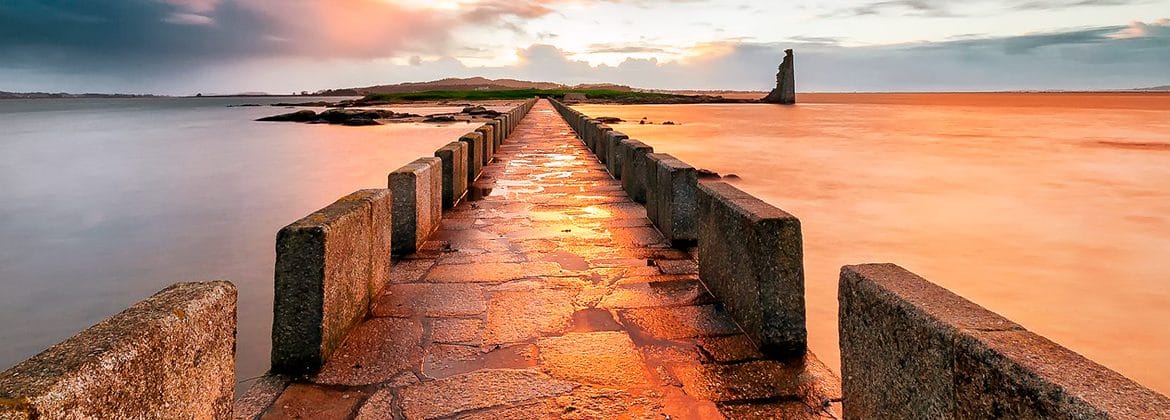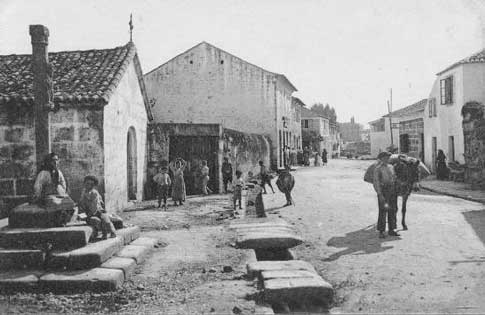The village of Cambados was declared a Cultural World Heritage Site in 2001, and you can explore its center, which is divided into three historic neighborhoods that were formerly independent. These neighborhoods are Fefiñáns, the ancient aristocratic district and the commercial center; Cambados, the administrative center; and Santo Tomé, an excellent fishing neighborhood.
We begin our journey in Fefiñáns and its pazo, which is in the plaza with the same name. The palace, which stood by the sea until the 18th century, was constructed in the 16th century by Juan Sarmiento Valladares, an advisor to Felipe II, but the building you can currently see is the result of remodeling. It is formed by two L-shaped structures and a battle tower from which two circular balconies protrude in a pulpit shaped corner. In the Palacio de Fefiñáns, which was converted into a winery in 1905, you can find the Albariño wine that we have been talking about, as well as Aguardiente and Orujo. In the same plaza, but at the other end, there is the Iglesia de San Benito, rebuilt in the late 18th century in the Baroque style with an ancient Roman chapel. Its most distinguishing elements are its Churrigueresque baroque bell towers and its Gothic interior.
Other places of interest in Fefiñáns include the Plaza de Asorey, dedicated to the popular sculptor of the 20th century; the Pazo de Torrado (currently the Museo del Vino), built in the 18th century; the Casa–Museo del Escritor Ramón Cabanillas, in which you’ll also find the tourism center; and the Pazo de Bazán, built in the 17th century by an ancestor of the novelist Emilia Pardo Bazán, and rebuilt in the 60s and converted into the Parador Nacional de Turismo.
The neighborhood of Cambados, distinguished by its tree-lined path of the Calzada, is where you’ll find the monument dedicated to the poet Ramón Cabanillas, the house of Ayuntamiento, and the Pazo Fajardo from the 17th century. Pay close attention to the exterior of the Casa de las Conchas. It is beautifully decorated with clear, Baroque nuances, taking the form of scallop shells. The Plaza de Alfredo Brañas is also worth a visit. It is flanked by palm trees with a beautiful central fountain of carved stone. Among its religious architecture, the ancient Convento de San Francisco should be mentioned. It is a parish church, but it was originally founded in 1588. Its Renaissance and neoclassical features along with its beautiful interior that houses an excellent image of the Virgin Mary help it to stand out among others.
The popular Pazo de Ulloa (15th century) sits on the road going up the Monte de la Pastora, and it currently forms part of the land of the house of rural tourism called A Capitana. The building is from the end of the 15th century or the beginning of the 16th, but renovations and extensions were made in the 18th century.
A little further up the Monte de la Pastora, you’ll find the most romantic structure in Cambados: the ruins of Santa Mariña de Dozo, declared a national monument in 1943. It consists of a Gothic church built in the 15th century over a different Roman church from the 12th century. It has a single nave divided by four transverse arches, five side chapels, a sacristy, and the main chapel. It caught fire in the 19th century, and its ruin motivated (by burying the outside cemetery) the inhabitants to use the interior of the ruins to entomb their dead. This led to the formation of a disorganized yet beautiful improvised cemetery. For the writer Álvaro Cunquiero, its beautiful half-arches “were there to hold out the wind.” On the same mountain you can also climb up to the Mirador de La Pastora, from which you can take in the breathtaking views of the River Arousa.


